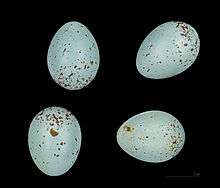Black-eared wheatear
| Black-eared wheatear | |
|---|---|
 | |
| Adult male of eastern race (O. h. melanoleuca) | |
| Scientific classification | |
| Kingdom: | Animalia |
| Phylum: | Chordata |
| Class: | Aves |
| Order: | Passeriformes |
| Family: | Muscicapidae |
| Genus: | Oenanthe |
| Species: | O. hispanica |
| Binomial name | |
| Oenanthe hispanica (Linnaeus, 1758) | |

The black-eared wheatear (Oenanthe hispanica) is a wheatear, a small migratory passerine bird that was formerly classed as a member of the thrush family Turdidae, but is now more generally considered to be an Old World flycatcher (family Muscicapidae).
This 13.5–15.5 cm (5.3–6.1 in) long insectivorous species is dimorphic with eastern and western races, sometimes split as eastern black-eared wheatear (Oenanthe melanoleuca) and western black-eared wheatear (which then retains the name hispanica). In both forms, birds with or without a black throat are met with.
The breeding male of the western form O. h. hispanica of the Iberian peninsula and north Africa has the forehead and crown white or nearly white, the mantle buff, and the wings blacker than those of the northern wheatear. The underparts are white tinged with buff. The back, upper tail coverts and most of the tail are white. The ear coverts and a line from the bill, and sometimes the throat, are black.
In autumn and winter the head and mantle are distinctly buff, as are the underparts, including the throat, but the buff varies in intensity. Except for the central pair, the tail feathers are much whiter than in the northern wheatear, the white on the inner web often extending to the tip.
The female is a browner bird, but has the characteristic lower back, and her seasonal changes are less marked.
The eastern O. h. melanoleuca is found in the eastern Mediterranean, and migrates to winter quarters in the Sudan.
The male of the eastern form is even whiter in summer than the western bird, but as a rule may be distinguished by the line which extends across the base of the bill. Black-throated individuals of this race have a greater amount of black on the throat and face than on the western birds, and the black generally terminates more abruptly or in a straighter line.
It is a rare vagrant to northwest Europe.
Etymology
The genus name Oenanthe is derived from the Ancient Greek oenos (οίνος) "wine" and anthos (ανθός) "flower". It refers to the northern wheatear's return to Greece in the spring just as the grapevines blossom. The specific hispanica is Latin for "Spanish".[2] "Wheatear" is not derived from "wheat" or any sense of "ear", but is a 16th-century linguistic corruption of "white" and "arse", referring to the prominent white rump found in most species.[3]
References
- ↑ BirdLife International (2012). "Oenanthe hispanica". IUCN Red List of Threatened Species. Version 2013.2. International Union for Conservation of Nature. Retrieved 26 November 2013.
- ↑ Jobling, James A. (2010). The Helm Dictionary of Scientific Bird Names. London, United Kingdom: Christopher Helm. pp. 193, 280. ISBN 978-1-4081-2501-4.
- ↑ "Wheatear". Oxford English Dictionary (3rd ed.). Oxford University Press. September 2005. (Subscription or UK public library membership required.)
Further reading
- Ullman, Magnus (1994) Identification of Pied Wheatear and Eastern Black-eared Wheatear Dutch Birding 16(5): 186-194
- Ullman, Magnus (2003) Separation of Western and Eastern Black-eared Wheatear Dutch Birding 25: 77-97
External links
- Black-eared Wheatear videos, photos & sounds on the Internet Bird Collection
- Ageing and sexing (PDF; 3.8 MB) by Javier Blasco-Zumeta & Gerd-Michael Heinze
